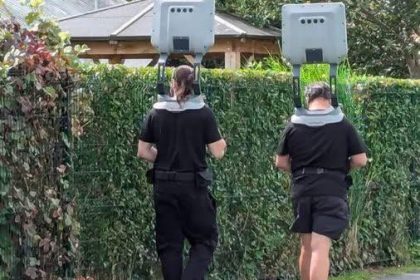A tragedy unfolded in Louisville this week when UPS Flight 2976, a cargo aircraft bound for Dallas, crashed moments after takeoff from Muhammad Ali International Airport. The fiery wreck claimed at least twelve lives, including all three crewmembers and a nearby child, injured fifteen others, and left sixteen people unaccounted for. Officials warn that the death toll could still rise as search and recovery operations continue.
According to early reports from the National Transportation Safety Board (NTSB), the McDonnell Douglas MD-11F freighter lifted off just after 6:00 a.m. on Tuesday, November 4, 2025, before experiencing catastrophic mechanical failure. Investigators say the left engine detached during the takeoff roll, shearing away from the wing and igniting a massive fire as the aircraft struggled to gain altitude. It remained airborne for only seconds before slamming into an industrial area less than a mile from the runway.
Firefighters battled intense flames for hours as debris scattered across several blocks, setting nearby buildings and vehicles ablaze. The crash left a half-mile debris field that emergency crews are still combing through. The coroner’s office confirmed that among the victims were the three-person flight crew and a child who lived in a nearby housing complex.
UPS has temporarily suspended operations at its Worldport facility — the company’s global air hub located at the same airport — while emergency crews continue recovery efforts. Airport officials limited other flight activity to two runways, as investigators secure the crash site and analyze evidence. Louisville Metro officials initially issued a shelter-in-place order due to heavy smoke and possible chemical exposure from burning jet fuel and building materials. That order was later reduced to a smaller radius after air-quality tests showed improvement.
The NTSB confirmed that both the cockpit voice recorder (CVR) and the flight data recorder (FDR) have been recovered and sent to Washington, D.C., for analysis. Preliminary readouts are expected to reveal the exact moment the engine detached and what steps the crew attempted in the final seconds of flight.
The aircraft involved, registration number N259UP, was delivered in the early 1990s and converted for cargo service several years later. Though aging, the MD-11F remains a workhorse for freight carriers like UPS and FedEx. Boeing, which absorbed McDonnell Douglas in 1997, is assisting the NTSB in the investigation.
Experts note that an engine separation during takeoff is one of the most dangerous mechanical failures possible. The loss of an engine can not only cripple thrust but also damage hydraulic and fuel systems, cause severe imbalance, and scatter debris across the runway. “The MD-11’s design has multiple safeguards, but if a pylon fails under high load, there’s little margin for recovery,” said retired airline captain Doug Whitmore.
Security footage captured from the airport perimeter shows the left engine breaking free as the aircraft accelerated, followed by the wing igniting in a burst of flame. The jet lifted briefly before rolling left and crashing into a cluster of warehouses near Fern Valley Road.
The NTSB’s early focus includes several technical areas:
– Structural failure: Investigators will conduct metallurgical testing on the pylon and wing fittings to determine if fatigue, corrosion, or improper maintenance contributed to the break.
– Maintenance history: Records from UPS’s engineering division will be reviewed for any past anomalies involving that engine or aircraft.
– Operational factors: Analysts will examine takeoff weight, speed calculations, and crew inputs to ensure proper performance procedures were followed.
– Human factors: The agency will look at crew experience, fatigue levels, and adherence to checklists during the emergency.
The investigation could take months, but the NTSB expects to issue an initial summary within ten days outlining factual findings. The final report, including probable cause, often takes more than a year.
For many, the crash echoes the 1979 disaster of American Airlines Flight 191 in Chicago, another case involving a DC-10 series aircraft that lost an engine and crashed during takeoff. While the MD-11 was developed from the DC-10 design, aviation experts caution against assuming a direct link. Modern engineering, maintenance practices, and inspection standards have evolved drastically in the decades since.
Louisville Mayor Craig Greenberg declared a state of emergency hours after the crash. “Our community is grieving tonight,” he said. “We’ve lost neighbors, friends, and dedicated aircrew who helped keep our economy running. We stand together in mourning and in strength.”
Local hospitals, including UofL Health and Norton Hospital, treated at least fifteen injured victims, most suffering from burns and smoke inhalation. Two remain in critical condition. Authorities continue cross-referencing hospital admissions with missing persons reports to confirm the total casualty count.
Residents living near the impact zone were advised not to use tap water until environmental tests confirm it’s safe. Hazmat teams are conducting air and soil sampling, as the burning wreckage released potentially toxic residues. Cleanup and remediation could take weeks.
UPS released a statement expressing “profound sorrow” and pledging full cooperation with investigators: “We are heartbroken by the loss of our colleagues and the community members affected by this tragic event. Our focus is on supporting families, employees, and first responders.”
Aviation regulators worldwide are closely watching the investigation. If structural fatigue or design flaws are confirmed, the Federal Aviation Administration (FAA) could issue mandatory inspections or grounding orders for other MD-11F aircraft. Boeing engineers are already assisting in teardown analysis of the recovered engine and its attachment assembly.
Witnesses near the airport described hearing a “thunderous boom” and seeing a “fireball across the sky.” One truck driver said, “It looked like daylight exploded behind me. The ground shook, and debris started raining down.”
Community centers across Louisville have opened shelters and counseling services for affected families. Volunteers are organizing blood drives and collecting donations for victims through the Red Cross. Flags across the city have been lowered to half-staff.
NTSB Member Todd Inman, who is leading the investigation, said during a press briefing, “Our goal is not only to determine what went wrong but to ensure it never happens again. Every piece of evidence, every rivet, and every second of data will be analyzed.”
As crews continue to sift through the wreckage, residents have placed flowers and candles near the site. Many say the tragedy has shaken a city long accustomed to the hum of aircraft overhead. Louisville’s Worldport, the heart of UPS’s global operations, handles hundreds of flights a day.
One resident summed up the collective heartbreak: “We hear those planes every night and think nothing of it. They’re just part of our lives. Until one doesn’t make it.”
For now, investigators, families, and a grieving city wait for answers. Flight 2976’s final seconds are preserved in its recorders — the story of a routine takeoff turned catastrophe. The search for why it happened has just begun.




